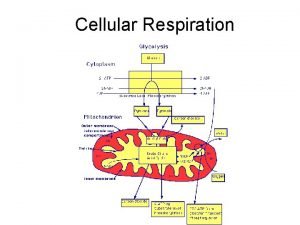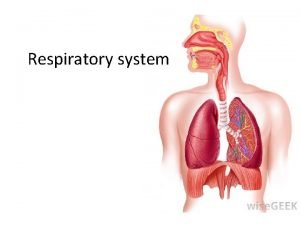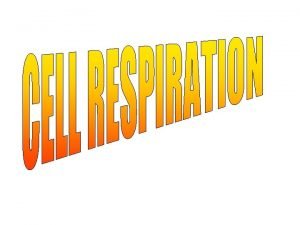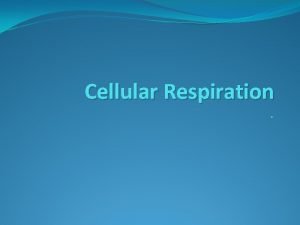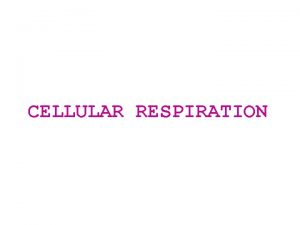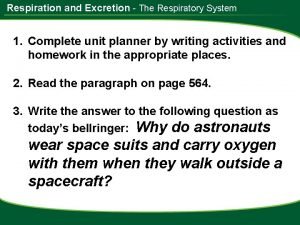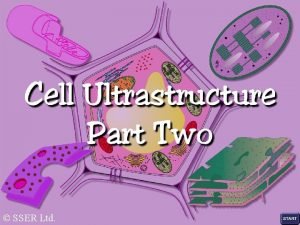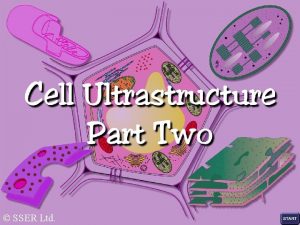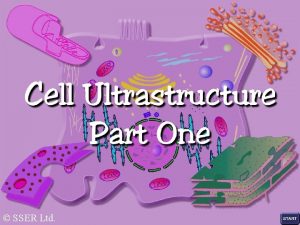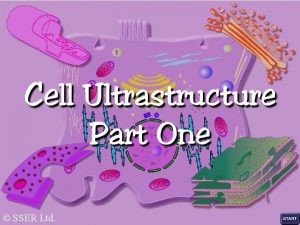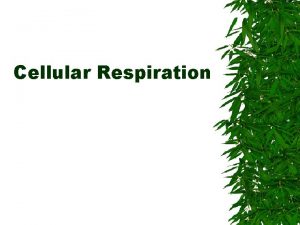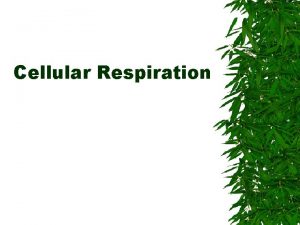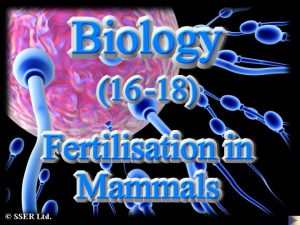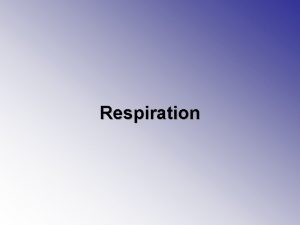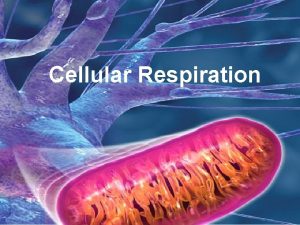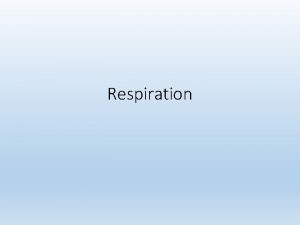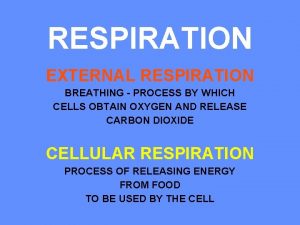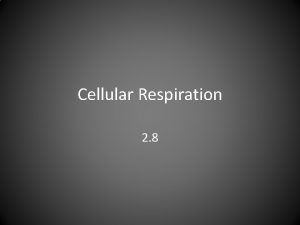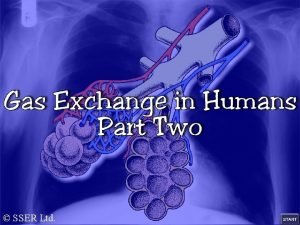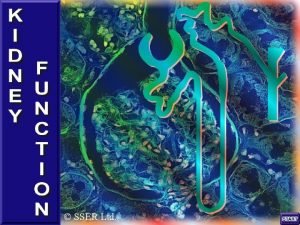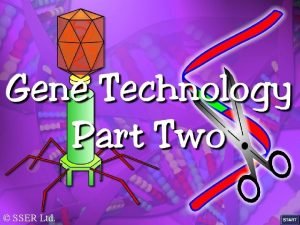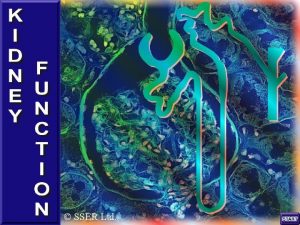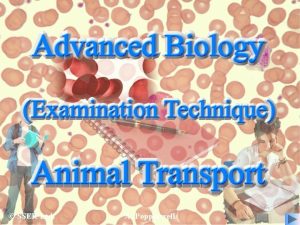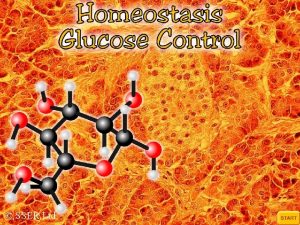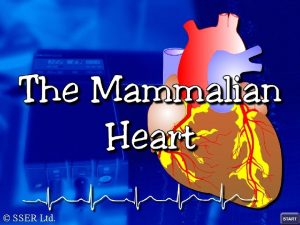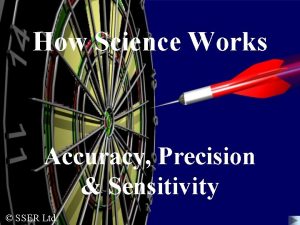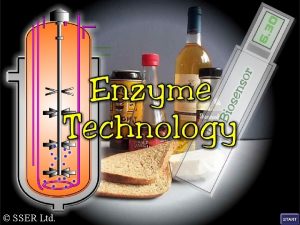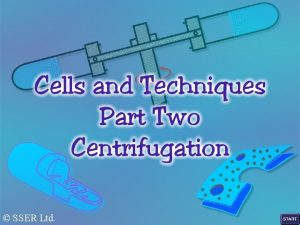SSER Ltd Respiration The process that allows cells















































- Slides: 47

© SSER Ltd.

Respiration The process that allows cells to produce ATP from glucose It can be done aerobically (with oxygen) or anerobically (without oxygen)

The overall equation for AEROBIC RESPIRATION IS: Glucose + Oxygen C 6 H 12 O 6 + 6 O 2 Carbon Dioxide + 6 CO 2 + 6 H 2 O + Water + energy The energy generated during the process of respiration is lost as heat unless it is trapped and stored Molecules of ATP ENERGY store much of the released energy

ATP forms when chemical reactions release sufficient energy to bond a third phosphate group to ADP Adenosine diphosphate (ADP) + Adenosine triphosphate (ATP) + energy High energy bond

ATP is the energy currency for the cell ATP stores energy for the cell and releases it when energy is needed This reaction is reversible and is catalysed by the enzyme ATPase ATP breaks down when there is a demand for energy

ATP – Why is it a good energy source? Stores or releases small amounts of energy at a time so no energy is wasted Easily broken down so energy can be released easily Can transfer energy by transferring a phosphate group Small and soluble – easily transported Cant pass out of a cell so the cell always has a supply of energy THINK – Small, manageable, transportable!

A Level Respiration C 6 H 12 O 6 + 6 O 2 6 CO 2 + 6 H 2 O + 38 ATP Only an overview!! “Respiration is a series of reactions in which energy is transferred from organic compounds, such as carbohydrates, to the temporary energy store, ATP. ”

The Energy producer of the Cell Mitochondria • Found in all cell types. • Found in higher numbers in cells that have higher energy demands. • 1µm diameter 10µm long.

Structure of a Mitochondrion

Structure of a Mitochondrion Outer membrane DNA Ribosomes Crista (fold in inner membrane) Stalked particles Matrix

What Happens Where? • Glycolysis = Cytoplasm of the cell. • Link reaction = Matrix of the mitochondria. • Krebs cycle = Also in the matrix. • Electron transfer chain Utilises proteins found in the membrane of the crista.

Remember this. . . . There are three coenzymes involved in respiration • NAD • Coenzyme A • FAD

There are three coenzymes involved in respiration • NAD • Coenzyme A • FAD NAD and FAD transfer hydrogen from one molecule to another (so can oxidise or reduce a molecule) Coenzyme A transfers acetate between molecules

Redox reactions are when something is reduced or oxidised. When something is reduced it may have • Gained electrons • Gained hydrogen • Lost oxygen When something is oxidised it may have • Lost electrons • Lost hydrogen • Gained oxygen Remember OIL RIG Oxidation of one molecule always involved reduction of another

1 3 2 4 Oxidative phosphorylation

The first three stages are a series of reactions The products from the first three stages are used here to produce ATP

Glycolysis Cytoplasm of the cell The link reaction Mitochondria Krebs Cycle Mitochondria The electron transport chain Mitochondria Glycolysis happens in the cytoplasm because the glucose is too large to pass through the outer membrane of the mitochondria

Additional information All cells use glucose to respire, but organisms can also break down other complex organic molecules (fatty acids, amino acids) which can then be respired Remember how the light independent reaction in photosynthesis doesn't just produce glucose (plants)

• The first stage of respiration is called glycolysis • It is the first stage in both aerobic and anaerobic respiration (it doesnt need oxygen to take place so is an anaerobic process!)

Glycolysis involves the breakdown of one molecule of glucose (6 C) to form 2 molecules of pyruvate (3 C) There are two stages to glycolysis: - 1. Phosphorlylation Adding a phosphate group 2. Oxidation Loss of hydrogen/electrons Gain of oxygen

Glucose (6 C) Phosphorylation ATP ADP Pi Fructose phosphate (6 C) ATP ADP Pi Fructose bisphosphate (6 C) 2 x triose phosphate (3 C) 2 x Pyruvate (3 C) 1. Glucose is phosphorylated using a phosphate from ATP. This creates 1 molecule of fructose phosphate and 1 molecule of ADP 2. ATP is then used to add a phosphate forming fructose bisphosphate

*NOTE* Its important to remember that 1 molecule of glucose gets phosphorylated using 1 molecule of ATP to produce 1 molecule of fructose phosphate 1 molecule of glucose phosphate is phosphorylated using 1 molecule of ATP to produce 1 molecule of fructose bisphosphate

Glucose (6 C) Phosphorylation ATP ADP Pi Fructose phosphate (6 C) ATP ADP Pi Fructose bisphosphate (6 C) 2 x triose phosphate (3 C) 2 x Pyruvate (3 C) 3. Fructose bisphosphate is then split into 2 molecules of triose phosphate

Glucose (6 C) ATP ADP Pi Fructose phosphate (6 C) Oxidation ATP ADP Pi Fructose bisphosphate (6 C) 4. Triose Phosphate is oxidised (loses hydrogen) forming two molecules of pyruvate 2 x triose phosphate (3 C) 4 ADP + 4 Pi 2 H+ 4 ATP 2 NAD 2 Reduced NAD 2 x Pyruvate (3 C)

Glucose (6 C) ATP ADP Pi 5. NAD collects the hydrogen ions (from the oxidised TP), forming reduced 2 molecules of NAD Fructose phosphate (6 C) Oxidation ATP ADP Pi Fructose bisphosphate (6 C) 4 ATP are produced but two were used up in stage one so there's a net gain of 2 ATP 2 x triose phosphate (3 C) 4 ADP + 4 Pi 2 H+ 4 ATP 2 NAD 2 Reduced NAD 2 x Pyruvate (3 C)

Glucose ATP Phosphorylation ADP Fructose phosphate (6 C) ADP ATP Fructose bisphosphate (6 C) Hydrolysis H 2 O 2 X Triose phosphate (3 C) Oxidation 4 ADP 2 NAD+ 4 Pi 4 H 2 X Pyruvate (3 C) 4 ATP 2 NADH + 2 H+

Stage 1 - Phosphorylation • Glucose is phosphorylated by adding 2 phosphates from 2 molecules of ATP. • Glucose is split using water(hydrolysis). • 2 molecules of triose phosphate are created and 2 molecules of ATP are used up.

Stage 2 - Oxidation • 4 ATP are produced, but 2 were used at the start, so there’s a net gain of 2 ATP. • Coenzyme NAD+ collects the hydrogen ions forming 2 Reduced NAD+ (NADH + H+) • The triose phosphate is oxidised (loses hydrogen), forming 2 molecules of pyruvate.

Glycolysis Glycogen NAD+ + 2 H NADH + H+ (oxidised form ) (reduced form) NB Rather then write NADH, examiners often simply refer to it as reduced NAD or reduced coenzyme You start with glycogen. 2 ATP 4 ADP + 4 Pi Glyceraldehyde 3 -phosphate (Triose Phosphate) (3 C x 2) Glucose (6 C) 2 ADP 4 ATP Pyruvate (3 C x 2) 2 H x 2 NAD Reduced NAD Nicotinamide adenine dinucleotide = So it gains electrons You finish with Pyruvate Why is Glycolysis termed anaerobic? What is the NET production of ATP?

The sums • The end products of glycolysis are pyruvate and reduced NAD • Energy is released during this reaction. • 4 molecules of ADP + Pi converted to 4 molecules of ATP. • So net gain of 2 molecules of ATP • 2 pairs of hydrogen atoms produced • 2 Molecules of pyruvate.

Products of glycolysis Products from glycolysis Where it goes 2 reduced NAD (NADH + H+) To oxidative phosphorylation 2 Pyruvate To the link reaction (actively transported) 2 ATP (net gain) Used for Energy

The Fate of Pyruvate! THIS DEPENDS ON THE AVAILABILITY OF OXYGEN!!!

Exam Questions Flash Cards

The second stage in aerobic respiration is called the link reaction Converts pyruvate produced in glycolysis into acetyl Co. A *ONLY INVOLVED IN AEROBIC RESPIRATION (NOT ANAEROBIC)*

Aerobic Respiration • If O 2 is present 3 C pyruvate passes into mitochondria. • Here it is completely oxidised forming CO 2 and H 2 O. • The second stage of aerobic respiration is the link reaction.

The Link Reaction Cytoplasm Glycolysis The Link reaction Mitochondria The Krebs Cycle Links Glycolysis to the Krebs Cycle. The end product of the link reaction can enter the Krebs Cycle.

Pyruvate (3 C) CO 2 NAD 1. Pyruvate is decarboxylated (carbon removed) in the form of carbon dioxide One carbon is removed 2. At the same time pyruvate is oxidised to form acetate NAD is reduced to form reduced NAD Reduced NAD Acetate (2 C) Acetyl Co. A (2 C) *Note* this is where some of the carbon dioxide is created which we will breathe out / will leave the plant

Pyruvate (3 C) CO 2 NAD 3. Acetate is combined with coenzyme A (Co. A) to form acetyl coenzyme A (acetyl Co. A) Reduced NAD Acetate (2 C) 4. No ATP is produced in this reaction Co enzyme A (Co. A) Acetyl Co. A (2 C)

Pyruvate (3 C) CO 2 NAD Two pyruvate molecules are made for every glucose molecule that enters glycolysis (so the link reaction is happening twice) Reduced NAD Acetate (2 C) Co enzyme A (Co. A) Acetyl Co. A (2 C)

NAD+ NADH + H+ Acetate (2 C) Pyruvate (3 C) Coenzyme A Acetyl coenzyme A (2 C) CO 2 Coenzyme A now combines with the Acetate The Pyruvate is decarboxylated (CO 2) to form Start with Pyruvate produced in Glycolysis This produces Acetate Acetyl coenzyme It is also dehydrogenated (H+Aremoved) The Acetyl coenzyme A now enters Krebs cycle

Link Reaction • One carbon atom is removed from pyruvate in the form of CO 2. • The remaining 2 -carbon molecule combines with coenzyme A to produce Acetyl Coenzyme A (acetyl Co. A). • Another oxidation reaction occurs when NAD+ collects more hydrogen ions. This forms reduced NAD (NADH + H +) • No ATP is produced in this reaction. Pyruvate(3 C) Decarboxylation CO 2 (1 C) Oxidation Coenzyme (Co. A) NAD+ Reduction NADH + H+ Acetyl Co. A (2 C)

The Link Reaction occurs Twice for every Glucose Molecule • For each glucose molecule used in glycolysis, two pyruvate molecules are made. • But the link reaction uses only one pyruvate molecule, so the link reaction and the Krebs cycle happen twice for every glucose molecule which goes through glycolysis. Overall equation for one link reaction and Kreb cycle: Pyruvate + NAD + Co. A acetyl Co. A + reduced NAD + CO 2

Products of the link reaction Products from two link reactions Where it goes 2 acetyl Co. A To Krebs cycle 2 carbon dioxide Released as waste product 2 reduced NAD To oxidative phosphorylation (electron transfer chain) Remember there are two link reactions going on because there are two pyruvates made from one glucose in glycolysis

Flash Cards

Summary Questions Complete the table below Substance ATP Reduced NAD CO 2 Glycolysis Link Reaction

Summary Questions Complete the table below Substance ATP Reduced NAD CO 2 Glycolysis X X Link Reaction X X

A 2 book – Page 50
 Internal respiration vs external respiration
Internal respiration vs external respiration Respiration
Respiration Ngoại tâm thu thất chùm đôi
Ngoại tâm thu thất chùm đôi Block nhĩ thất độ 2 mobitz 2
Block nhĩ thất độ 2 mobitz 2 Thơ thất ngôn tứ tuyệt đường luật
Thơ thất ngôn tứ tuyệt đường luật Thơ thất ngôn tứ tuyệt đường luật
Thơ thất ngôn tứ tuyệt đường luật Chiến lược kinh doanh quốc tế của walmart
Chiến lược kinh doanh quốc tế của walmart Tìm độ lớn thật của tam giác abc
Tìm độ lớn thật của tam giác abc Hãy nói thật ít để làm được nhiều
Hãy nói thật ít để làm được nhiều Tôn thất thuyết là ai
Tôn thất thuyết là ai Gây tê cơ vuông thắt lưng
Gây tê cơ vuông thắt lưng Sau thất bại ở hồ điển triệt
Sau thất bại ở hồ điển triệt Sphenoid paranasal sinus
Sphenoid paranasal sinus Dr saja
Dr saja Pineal gland
Pineal gland Somatic cells vs gametes
Somatic cells vs gametes Why dna is more stable than rna?
Why dna is more stable than rna? Red blood cells and white blood cells difference
Red blood cells and white blood cells difference Eucariote
Eucariote Animal cells and plant cells venn diagram
Animal cells and plant cells venn diagram Prokaryotes vs eukaryotes venn diagram
Prokaryotes vs eukaryotes venn diagram The organelle trail
The organelle trail Masses of cells form and steal nutrients from healthy cells
Masses of cells form and steal nutrients from healthy cells Label
Label Cuál es la diferencia entre la célula animal y vegetal
Cuál es la diferencia entre la célula animal y vegetal Prokaryotic cell wall
Prokaryotic cell wall Nondisjunction in meiosis
Nondisjunction in meiosis Cells and life lesson 1 answer key
Cells and life lesson 1 answer key The process of photosynthesis and cellular respiration
The process of photosynthesis and cellular respiration Cellular respiration process diagram
Cellular respiration process diagram External vs internal respiration
External vs internal respiration Meaning of cellular respiration
Meaning of cellular respiration Steps 1
Steps 1 Cellular respiration is a complex process that
Cellular respiration is a complex process that Flow chart of respiratory system
Flow chart of respiratory system Hình ảnh bộ gõ cơ thể búng tay
Hình ảnh bộ gõ cơ thể búng tay Slidetodoc
Slidetodoc Bổ thể
Bổ thể Tỉ lệ cơ thể trẻ em
Tỉ lệ cơ thể trẻ em Chó sói
Chó sói Chụp tư thế worms-breton
Chụp tư thế worms-breton Bài hát chúa yêu trần thế alleluia
Bài hát chúa yêu trần thế alleluia Môn thể thao bắt đầu bằng chữ f
Môn thể thao bắt đầu bằng chữ f Thế nào là hệ số cao nhất
Thế nào là hệ số cao nhất Các châu lục và đại dương trên thế giới
Các châu lục và đại dương trên thế giới Công thức tính thế năng
Công thức tính thế năng Trời xanh đây là của chúng ta thể thơ
Trời xanh đây là của chúng ta thể thơ Cách giải mật thư tọa độ
Cách giải mật thư tọa độ





























